Progress and Trends in Forage Cactus Silage Research: A Bibliometric Perspective
Abstract
:1. Introduction
2. Materials and Methods
2.1. Data Source and Search Strategy
2.2. Screening Strategy
2.3. Bibliometric Maps and Statistical Analyses
3. Results and Discussion
3.1. Trends in Publications
3.2. Keyword Analysis
3.3. Most Cited Articles
| Document Title | Authors | Year | Journal | TC 1/FWCI | Ref. |
|---|---|---|---|---|---|
| Effect of feeding cactus-legume silages on nitrogen retention, digestibility and microbial protein synthesis in goats | Gusha, J., Halimani, T.E., Ngongoni, N.T., Ncube, S. | 2015 | Anim. Feed Sci. Technol. | 26/1.12 | [28] |
| Mixed silages of cactus pear and gliricidia: chemical composition, fermentation characteristics, microbial population and aerobic stability | da Silva Brito, G.S.M., Santos, E.M., de Araújo, G.G.L., (…), de Oliveira Lima, A.G.V., Cavalcanti, H.S. | 2020 | Scientific Reports | 24/0.88 | [31] |
| Silages in the form of diet based on spineless cactus and buffelgrass | Macêdo, A.J.D.S., Santos, E.M., de Araújo, G.G.L., (…), Sá, W.C.C.S., Pereira, D.M. | 2018 | Afr J Range Forage Sci | 19/1.43 | [32] |
| Carcass traits and meat quality of lambs fed with cactus (Opuntia fíćus-indica Mill) silage and subjected to an intermittent water supply | do Nascimento Souza, A.F., de Araújo, G.G.L., Santos, E.M., (…), Pinho, R.M.A., de Moura Zanine, A. | 2020 | PLoS ONE | 18/0.75 | [2] |
| Isolation and identification of lactic acid bacteria in fresh plants and in silage from Opuntia and their effects on the fermentation and aerobic stability of silage | Pereira, G.A., Santos, E.M., Araújo, G.G.L., (…), Neto, J.M.C., Nascimento, T.V.C. | 2019 | Journal of Agricultural Science | 16/1.21 | [33] |
| Performance, body water balance, ingestive behavior and blood metabolites in goats fed with cactus pear (Opuntia ficus-indica L. Miller) silage subjected to an intermittent water supply | Albuquerque, I., Araújo, G., Santos, F., (…), Silva-Filho, E., Oliveira, R. | 2020 | Sustainability (Switzerland) | 14/1.13 | [34] |
| Water intake and ingestive behavior of sheep fed diets based on silages of cactus pear and tropical forages | Silva, T.S., de Araujo, G.G.L., Santos, E.M., (…), Ribeiro, O.L., Turco, S.H.N. | 2021 | Tropical Animal Health and Production | 12/2.59 | [30] |
| Fermentation profile and nutritional quality of silages composed of cactus pear and maniçoba for goat feeding | Matias, A.G.S., Araujo, G.G.L., Campos, F.S., (…), Emerenciano Neto, J.V., Voltolini, T.V. | 2020 | Journal of Agricultural Science | 10/1.07 | [35] |
| Intake, nutrient digestibility, nitrogen balance, and microbial protein synthesis in sheep fed spineless-cactus silage and fresh spineless cactus | Pereira, G.A., Santos, E.M., Oliveira, J.S.D., (…), Cruz, G.F.D.L., Leite, G.M. | 2021 | Small Ruminant Research | 9/2.16 | [29] |
| Silage composed of Opuntia ficus-indica f. inermis cladodes, olive cake and wheat bran as alternative feed for barbarine lamb | Abidi, S., Ben Salem, H., Nefzaoui, A., Vasta, V., Priolo, A. | 2013 | Acta Horticulturae | 9/- | [36] |
3.4. Analysis of Journal Productivity
3.5. Geographical Distribution and Affiliations
3.6. Areas of Scientific Knowledge
3.7. Analysis of Selected Articles
3.7.1. Forage Cactus Silage
3.7.2. Mixed Silages of Forage Cactus and Other Forages
3.7.3. Forage Cactus Silage with Industrial By-Products
3.7.4. Forage Cactus Silage in the Sheep Diet
3.7.5. Forage Cactus Silage in the Goats’ Diet
3.7.6. Forage Cactus Silage in the Bovine Diets
3.8. Overview and Future Prospects
4. Conclusions
Author Contributions
Funding
Institutional Review Board Statement
Informed Consent Statement
Data Availability Statement
Acknowledgments
Conflicts of Interest
References
- Anaya-Pérez, M.A. History of the Use of Opuntia as Forage in Mexico. FAO Plant Prod. Prot. Pap. 2001, 169, 5–12. [Google Scholar]
- do Nascimento Souza, A.F.; Leal de Araújo, G.G.; Santos, E.M.; Sérgio de Azevedo, P.; Silva de Oliveira, J.; Perazzo, A.F.; Pinho, R.M.A.; de Moura Zanine, A. Carcass Traits and Meat Quality of Lambs Fed with Cactus (Opuntia fícus-indica Mill) Silage and Subjected to an Intermittent Water Supply. PLoS ONE 2020, 15, e0231191. [Google Scholar] [CrossRef] [PubMed]
- De Ferreira, M.; Da Silva, F.M.; Bispo, S.V.; Azevedo, M.D. Strategies for the Supplementation of Dairy Cows in the Brazilian Semi-Arid. Rev. Bras. Zootec. 2009, 38, 322–329. [Google Scholar] [CrossRef]
- Rodrigues, P.G.; Garcez, D.S.M.; Silva, C.M.; Santana, C.C.S.; Santana, J.C.S.; Lopes, C.D.C.; Muniz, E.N.; de Oliveira Júnior, G.M.; Silva de Moura, R.; de Souza, J.C. Use of Palm Bran (Nopalea cochenillifera (L.) Salm-Dyck) in Partial Replacement of Concentrate in Maintenance Equine Diets—A Pilot Study. Arch. Anim. Breed. 2021, 64, 273–282. [Google Scholar] [CrossRef] [PubMed]
- Maia, S.M.F.; de Oliveira Galvão, C.; Abbruzzini, T.F.; Campo, J.; Orsini, J.A.M.; Cerri, C.E.P.; de Oliveira, T.S. 7 Managing Drought Stress in Agro-Ecosystems of Latin America and the Caribbean Region. Soil Drought Basic Process. 2023, 20, 24. [Google Scholar]
- Silva, P.C.G.d.; Moura, M.S.B.d.; Kiill, L.H.P.; Brito, L.T.d.L.; Pereira, L.A.; Sá, I.B.; Correia, R.C.; Teixeira, A.H.d.C.; Cunha, T.J.F.; Guimarães Filho, C. Caracterização Do Semiárido Brasileiro: Fatores Naturais e Humanos. In Semiárido Brasileiro: Pesquisa, Desenvolvimento e Inovação; Embrapa Semiárido: Petrolina, Brazil, 2010. [Google Scholar]
- Nobre, I.d.S.; Araújo, G.G.L.d.; Santos, E.M.; Carvalho, G.G.P.d.; de Albuquerque, I.R.R.; Oliveira, J.S.d.; Ribeiro, O.L.; Turco, S.H.N.; Gois, G.C.; Silva, T.G.F.d.; et al. actus Pear Silage to Mitigate the Effects of an Intermittent Water Supply for Feedlot Lambs: Intake, Digestibility, Water Balance and Growth Performance. Ruminants 2023, 3, 121–132. [Google Scholar] [CrossRef]
- Costa, R.G.; Beltrão Filho, E.M.; de Medeiros, A.N.; Givisiez, P.E.N.; do Egypto, R.d.C.R.; Melo, A.A.S. Effects of Increasing Levels of Cactus Pear (Opuntia ficus-indica L. Miller) in the Diet of Dairy Goats and its Contribution as a Source of Water. Small Rumin. Res. 2009, 82, 62–65. [Google Scholar] [CrossRef]
- Cordeiro, M.W.S.; Júnior, V.R.R.; Monção, F.P.; Palma, M.N.N.; Rigueira, J.P.S.; da Cunha Siqueira Carvalho, C.; da Costa, M.D.; D’Angelo, M.F.S.V.; Costa, N.M.; de Oliveira, L.I.S. Tropical Grass Silages with Spineless Cactus in Diets of Holstein× Zebu heifers in the Semiarid Region of Brazil. Trop. Anim. Health Prod. 2023, 55, 89. [Google Scholar] [CrossRef]
- Gebremariam, T.; Melaku, S.; Yami, A. Effect of Different Levels of Cactus (Opuntia ficus-indica) Inclusion on Feed Intake, Digestibility and Body Weight Gain in Tef (Eragrostis tef) Straw-Based Feeding of Sheep. Anim. Feed Sci. Technol. 2006, 131, 43–52. [Google Scholar] [CrossRef]
- Sobral, G.d.C.; de Oliveira, J.S.; Santos, E.M.; de Araújo, G.G.L.; de Sousa Santos, F.N.; Campos, F.S.; Cavalcanti, H.S.; de Souza Vieira, D.; Leite, G.M.; Coelho, D.F.O.; et al. Optimizing Silage Quality in Drylands: Corn Stover and Forage Cactus Mixture on Nutritive Value, Microbial Activity, and Aerobic Stability. J. Arid Environ. 2024, 220, 105123. [Google Scholar] [CrossRef]
- Ramos, J.P.F.; Santos, E.M.; Santos, A.P.M.; de Souza, W.H.; Oliveira, J.S. Ensiling of Forage Crops in Semiarid Regions. In Advances in Silage Production and Utilization; IntechOpen: London, UK, 2016; Volume 65. [Google Scholar]
- Rodrigues, A.M.; Pitacas, F.I.; Reis, C.; Blasco, M. Nutritional Value of Opuntia ficus-indica Cladodes from Portuguese Ecotypes. Bulg. J. Agric. Sci. 2016, 22, 40–45. [Google Scholar]
- Dunière, L.; Sindou, J.; Chaucheyras-Durand, F.; Chevallier, I.; Thévenot-Sergentet, D. Silage Processing and Strategies to Prevent Persistence of Undesirable Microorganisms. Anim. Feed Sci. Technol. 2013, 182, 1–15. [Google Scholar] [CrossRef]
- Mao, G.; Huang, N.; Chen, L.; Wang, H. Research on Biomass Energy and Environment from the Past to the Future: A Bibliometric Analysis. Sci. Total Environ. 2018, 635, 1081–1090. [Google Scholar] [CrossRef] [PubMed]
- Vieira, F.; Santana, H.E.P.; Silva, D.P.; Ruzene, D.S. A Bibliometric Description of Organosolv Pretreatment for Coconut Waste Valorization. BioEnergy Res. 2023, 16, 2115–2130. [Google Scholar] [CrossRef]
- Tang, R.; Zhang, S.; Ding, C.; Zhu, M.; Gao, Y. Artificial Intelligence in Intensive Care Medicine: Bibliometric Analysis. J. Med. Internet Res. 2022, 24, e42185. [Google Scholar] [CrossRef]
- Teles, M.N.O.; Santos, B.L.P.; Silva, D.P.; Teixeira, J.A.; Ruzene, D.S. A Bibliometric Description of Lignin Applicability for the Removal of Chemical Pollutants in Effluents. Water Air Soil Pollut. 2020, 231, 1–14. [Google Scholar] [CrossRef]
- Scopus Content Coverage Guide; Elsevier: Amsterdam, The Netherlands, 2020; pp. 1–24.
- Van Eck, N.; Waltman, L. Software Survey: VOSviewer, a Computer Program for Bibliometric Mapping. Scientometrics 2010, 84, 523–538. [Google Scholar] [CrossRef]
- Siqueira, M.; Chagas, J.; Monnerat, J.P.; Monteiro, C.; Mora-Luna, R.; Dubeux, J.; Dilorenzo, N.; Ruiz-Moreno, M.; Ferreira, M. Nutritive value, in Vitro Fermentation, and Methane Production of Cactus Cladodes, Sugarcane Bagasse, and Urea. Animals 2021, 11, 1266. [Google Scholar] [CrossRef]
- de Oliveira, P.V.C.; de Araújo, T.L.A.C.; Pinedo, L.A.; de Lima Júnior, D.M.; Cortes, L.C.D.S.L.; Firmino, S.S.; Pereira, M.W.F.; de Oliveira Lima, P. Mixed Sorghum and Forage Cactus Silage: Composition, Digestibility, Fermentation, and Losses Silagem Mista de Sorgo e Palma Forrageira: Composição, Digestibilidade, Fermentação e Perdas. Semin. Agrar. 2023, 44, 929–936. [Google Scholar] [CrossRef]
- Alencar, A.M.S.; Júnior, V.R.R.; Monção, F.P.; Cordeiro, M.W.S.; Santos, A.d.; Caldeira, L.A.; de Oliveira, L.; Ananias, J.V.A.; da Costa, M.; de Souza, A.; et al. Quality of Mixed Silages of Sorghum, BRS Capiaçu Grass, and Cactus Pear in a Semiarid Region of Brazil. J. Appl. Anim. Res. 2023, 51, 719–728. [Google Scholar] [CrossRef]
- Vastolo, A.; Calabrò, S.; Cutrignelli, M.I.; Raso, G.; Todaro, M. Silage of Prickly Pears (Opuntia spp.) Juice by-Products. Animals 2020, 10, 1716. [Google Scholar] [CrossRef] [PubMed]
- Marengo, J.A.; Cunha, A.P.M.A.; Nobre, C.A.; Ribeiro Neto, G.G.; Magalhaes, A.R.; Torres, R.R.; Sampaio, G.; Alexandre, F.; Alves, L.M.; Cuartas, L.A. Assessing Drought in the Drylands of Northeast Brazil under Regional Warming Exceeding 4 C. Nat. Hazards 2020, 103, 2589–2611. [Google Scholar] [CrossRef]
- Vieira, R.M.d.S.P.; Tomasella, J.; Cunha, A.P.M.d.A.; Barbosa, A.A.; Pompeu, J.; Ferreira, Y.; Santos, F.C.; Alves, L.M.; Ometto, J. Socio-Environmental Vulnerability to Drought Conditions and Land Degradation: An Assessment in two Northeastern Brazilian River Basins. Sustainability 2023, 15, 8029. [Google Scholar] [CrossRef]
- Uddin, S.; Khan, A. The Impact of Author-Selected Keywords on Citation Counts. J. Informetr. 2016, 10, 1166–1177. [Google Scholar] [CrossRef]
- Gusha, J.; Halimani, T.E.; Ngongoni, N.T.; Ncube, S. Effect of Feeding Cactus-Legume Silages on Nitrogen Retention, Digestibility and Microbial Protein Synthesis in Goats. Anim. Feed Sci. Technol. 2015, 206, 1–7. [Google Scholar] [CrossRef]
- Pereira, G.A.; Santos, E.M.; de Oliveira, J.S.; de Araújo, G.G.L.; de Sá Paulino, R.; Perazzo, A.F.; de Farias Ramos, J.P.; Neto, J.M.C.; de Lima Cruz, G.F.; Leite, G.M. Intake, Nutrient Digestibility, Nitrogen Balance, and Microbial Protein Synthesis in Sheep Fed Spineless-Cactus Silage and Fresh Spineless Cactus. Small Rumin. Res. 2021, 194, 106293. [Google Scholar] [CrossRef]
- Silva, T.S.; de Araujo, G.G.L.; Santos, E.M.; de Oliveira, J.S.; Campos, F.S.; Godoi, P.F.A.; Gois, G.C.; Perazzo, A.F.; Ribeiro, O.L.; Turco, S.H.N. Water Intake and Ingestive Behavior of Sheep Fed Diets Based on Silages of Cactus Pear and Tropical Forages. Trop. Anim. Health Prod. 2021, 53, 1–7. [Google Scholar] [CrossRef]
- da Brito, G.S.M.S.; Santos, E.M.; de Araújo, G.G.L.; de Oliveira, J.S.; Zanine, A.M.; Perazzo, A.F.; Campos, F.S.; de Lima, A.G.V.O.; Cavalcanti, H.S. Mixed Silages of Cactus Pear and Gliricidia: Chemical Composition, Fermentation Characteristics, Microbial Population and Aerobic Stability. Sci. Rep. 2020, 10, 6834. [Google Scholar] [CrossRef]
- da Macêdo, A.J.S.; Santos, E.M.; de Araújo, G.G.L.; Edvan, R.L.; de Oliveira, J.S.; Perazzo, A.F.; dos Sá, W.C.C.S.; Pereira, D.M. Silages in the Form of Diet Based on Spineless Cactus and Buffelgrass. Afr. J. Range Forage Sci. 2018, 35, 121–129. [Google Scholar] [CrossRef]
- Pereira, G.A.; Santos, E.M.; Araújo, G.G.L.; Oliveira, J.S.; Pinho, R.M.A.; de Zanine, A.M.; Souza, A.F.N.; Macedo, A.J.S.; Neto, J.M.C.; Nascimento, T.V.C. Isolation and Identification of Lactic Acid Bacteria in Fresh Plants and in Silage from Opuntia and Their Effects on the Fermentation and Aerobic Stability of Silage. J. Agric. Sci. 2019, 157, 684–692. [Google Scholar] [CrossRef]
- Albuquerque, I.; Araújo, G.; Santos, F.; Carvalho, G.; Santos, E.; Nobre, I.; Bezerra, L.; Silva-Júnior, J.; Silva-Filho, E.; Oliveira, R. Performance, Body Water Balance, Ingestive Behavior and Blood Metabolites in Goats Fed with Cactus Pear (Opuntia ficus-indica L. Miller) Silage Subjected to an Intermittentwater Supply. Sustainability 2020, 12, 2881. [Google Scholar] [CrossRef]
- Matias, A.G.S.; Araújo, G.G.L.; Campos, F.S.; Moraes, S.A.; Gois, G.C.; Silva, T.S.; Neto, J.V.E.; Voltolini, T.V. Fermentation Profile and Nutritional Quality of Silages Composed of Cactus Pear and Maniçoba for Goat Feeding. J. Agric. Sci. 2020, 158, 304–312. [Google Scholar] [CrossRef]
- Abidi, S.; Ben Salem, H.; Nefzaoui, A.; Vasta, V.; Priolo, A. Silage Composed of Opuntia ficus-indica f. Inermis Cladodes, Olive Cakeand Wheat Bran as Alternative Feed for Barbarine Lamb. Acta Hortic. 2013, 995, 297–302. [Google Scholar] [CrossRef]
- Santos, D.C.d.; Farias, I.; Lira, M.d.A.; Santos, M.V.F.d.; Arruda, G.P.d.; Coelho, R.S.B.; Dias, F.M.; de Melo, J.N. Manejo e Utilização Da Palma Forrageira (Opuntia e Nopalea) em Pernambuco; IPA: Recife, Brazil, 2006; 48p. [Google Scholar]
- de Lima Cruz, G.F.; Santos, E.M.; de Araújo, G.G.L.; de Azevedo, P.S.; de Albuquerque, Í.R.R.; Panosso, N.M.; Perazzo, A.F.; de Moura Zanine, A.; de Jesus Ferreira, D.; de Oliveira Lima, A.G.V.; et al. Carcass Traits and Meat Quality of Goats Fed with Cactus Pear (Opuntia ficus-indica Mill) Silage Subjected to an Intermittent Water Supply. Sci. Rep. 2023, 13, 855. [Google Scholar] [CrossRef]
- Rodrigues, R.; Lopes, R.; Santos, F.N.; Santos, E.M.; Perazzo, A.; Zanine, A.; Silva, R.; Silva, E.; Olivera-Viciedo, D.; Rocha, M.; et al. Total Mixed Ration Silages Based on Forage Cactus and Xerophile Legumes as Alternatives for Ruminants. Agriculture 2023, 13, 1759. [Google Scholar] [CrossRef]
- Silva, T.S.; de Araújo, G.G.L.; Santos, E.M.; de Oliveira, J.S.; Godoi, P.F.A.; Gois, G.C.; Perazzo, A.F.; Ribeiro, O.L.; Turco, S.H.N.; Campos, F.S. Intake, Digestibility, Nitrogen Balance and Performance in Lamb Fed Spineless Cactus Silage Associated with Forages Adapted to the Semiarid Environment Spineless cactus Silages in Diets for Lambs. Livest. Sci. 2023, 268, 105168. [Google Scholar] [CrossRef]
- Araújo, C.A.d.; de Oliveira, G.F.; Pinto, M.S.; Cunha, D.S.; Lima, R.S.; Costa, C.J.P.; Melo, D.A.d.S.; Campos, F.S.; Magalhães, A.L.R.; Gois, G.C. Fermentation Profile, Chemical Composition, and Aerobic Stability of Cassava Shoots Silages with Cactus pear. Braz. J. Vet. Res. Anim. Sci. 2023, 60, e212257. [Google Scholar] [CrossRef]
- Sá, W.C.C.d.S.; Santos, E.M.; Oliveira, J.S.d.; Araújo, G.G.d.; Perazzo, A.F.; Pereira, D.M.; Santos, F.N.D.S.; Macêdo, A.J.D.S.; Cruz, G.F.D.L.; Corrêa, Y.R.; et al. Qualitative Evaluation of Total Mixed Ration Silage Containing Forage Cactus and Guinea Grass as a Nutritional Alternative for Feedlot-Finished Sheep. N. Z. J. Agric. Res. 2023. [Google Scholar] [CrossRef]
- de Araújo, C.A.; de Pinto, M.S.; de Oliveira, G.F.; da Silva Rodrigues, J.M.D.C.; de Cunha, D.S.; de Costa, C.J.P.; de Melo, D.A.S.; Magalhães, A.L.R.; de Araújo, G.G.L.; Campos, F.S.; et al. Nutritional Properties and in vitro Gas Production in Cactus Pear (Opuntia stricta) and Cassava (Manihot esculenta) Shoot Silages. Afr. J. Range Forage Sci. 2023, 40, 392–400. [Google Scholar] [CrossRef]
- Ravari, F.N.; Tahmasbi, R.; Dayani, O.; Khezri, A. Cactus-Alfalfa Blend Silage as an Alternative Feedstuff for Saanen Dairy Goats: Effect on Feed Intake, Milk Yield and Components, Blood and Rumen Parameters. Small Rumin. Res. 2022, 216, 106811. [Google Scholar] [CrossRef]
- de Melo, D.A.S.; Leite, A.C.S.P.; da Lima, R.S.; da Rodrigues, J.C.S.; de Araújo, C.A.; de Cunha, D.S.; Costa, P.; de Jesus, C.; de Sá, N.; Kelly, M. The Inclusion of Cactus pear Changes the Fermentation Process, Chemical Composition and Aerobic Stability of Arboreal Cotton Silages. J. Prof. Assoc. Cactus Dev. 2022, 24. [Google Scholar] [CrossRef]
- Matlabe, G.; Mokoboki, H.K.; Sebola, A.N.; Lebopa, C.K.; Ravhuhali, K.E.; Hawu, O. Effects of Browse Legume Species Addition on Nutritional Composition, Fermentation Characteristics and Aerobic Stability of Opuntia cladodes Silage. S. Afr. J. Sci. 2022, 118, 1–6. [Google Scholar] [CrossRef] [PubMed]
- de Paulino, R.S.; de Oliveira, J.S.; Santos, E.M.; Pereira, G.A.; de Ramos, J.P.F.; César Neto, J.M.; de Cruz, G.F.L.; Leite, G.M.; Satake, F.; da Silva, A.L. Spineless Cactus Use Management on Microbiological Quality, Performance, and Nutritional Disorders in Sheep. Trop. Anim. Health Prod. 2021, 53, 1–14. [Google Scholar] [CrossRef] [PubMed]
- Sá, W.; Santos, E.M.; de Oliveira, J.S.; de Araujo, G.G.L.; Perazzo, A.F.; da Silva, A.L.; Pereira, D.M.; Neto, J.M.C.; Santos, F.N.S.; Leite, G.M. Fermentative Characteristics and Chemical Composition of Cochineal Nopal Cactus Silage Containing Chemical and Microbial Additives. J. Agric. Sci. 2020, 158, 574–582. [Google Scholar] [CrossRef]
- Santos, F.N.S.; Santos, E.M.; Oliveira, J.S.; Medeiros, G.R.; Zanine, A.M.; Araújo, G.G.L.; Perazzo, A.F.; Lemos, M.L.P.; Pereira, D.M.; Cruz, G.F.L. Fermentation Profile, Microbial Populations, Taxonomic Diversity and Aerobic Stability of Total Mixed Ration Silages Based on Cactus and Gliricidia. J. Agric. Sci. 2020, 158, 396–405. [Google Scholar] [CrossRef]
- de Carvalho, C.B.M.; Loiola Edvan, R.; dos Nascimento, K.S.; do Nascimento, R.R.; Bezerra, L.R.; de Jácome, D.L.S.; dos Santos, V.L.F.; de Santana Júnior, H.A. Methods of Storing Cactus Pear Genotypes for Animal Feeding. African J. Range Forage Sci. 2020, 37, 173–179. [Google Scholar] [CrossRef]
- Monção, F.P.; Rocha Júnior, V.R.; Silva, J.T.; De Jesus, N.G.; Marques, O.F.C.; Rigueira, J.P.S.; Sales, E.C.J.; Silva Júnior, A.A.G.; Alves, D.D.; Carvalho, C.C.C. Nutritional Value of BRS Capiaçu Grass (Pennisetum purpureum) Silage Associated with Cactus Pear. Iran. J. Appl. Anim. Sci. 2020, 10, 25–29. [Google Scholar]
- da Santos, R.S.; Emerenciano Neto, J.V.; de Souza Bonfim, B.R.; Fonseca dos Santos, U.L.; Rodrigues, A.C.; Lista, F.N.; dos Difante, G.S.; do Vale Bezerra, J.D. Fermentation Losses of Cactus Silages with Elephant Grass. J. Prof. Assoc. cactus Dev. 2020, 22, 72–78. [Google Scholar] [CrossRef]
- de Nogueira, M.S.; de Araújo, G.G.L.; Santos, E.M.; Neto, S.G.; de Oliveira, J.S.; Perazzo, A.F.; de Zanine, A.M.; Pinho, R.M.A.; Corrêa, Y.R.; Pereira, D.M. Feed Alternatives with Cactus Forage Silage for Animal Nutrition. Int. J. Agric. Biol. 2019, 22, 1393–1398. [Google Scholar] [CrossRef]
- Fuentes-Rodriguez, J.; Abrego-Garcia, A.; Ruiz-Zarate, F.; Montero-Almora, G.; Torres Hernandez, M.; Murillo Soto, M.E.; Garcia-Castillo, R.; Lopez-Gonzalez, J.J.; Ortiz de la Rosa, B. In vitro Digestibility of Prickly Pear Cactus (Opuntia spp.) Additioned with Brewery by-Products. In Proceedings of the VII International Congress on Cactus Pear and Cochineal 995, Agadir, Morocco, 17–22 October 2010; pp. 313–317. [Google Scholar]

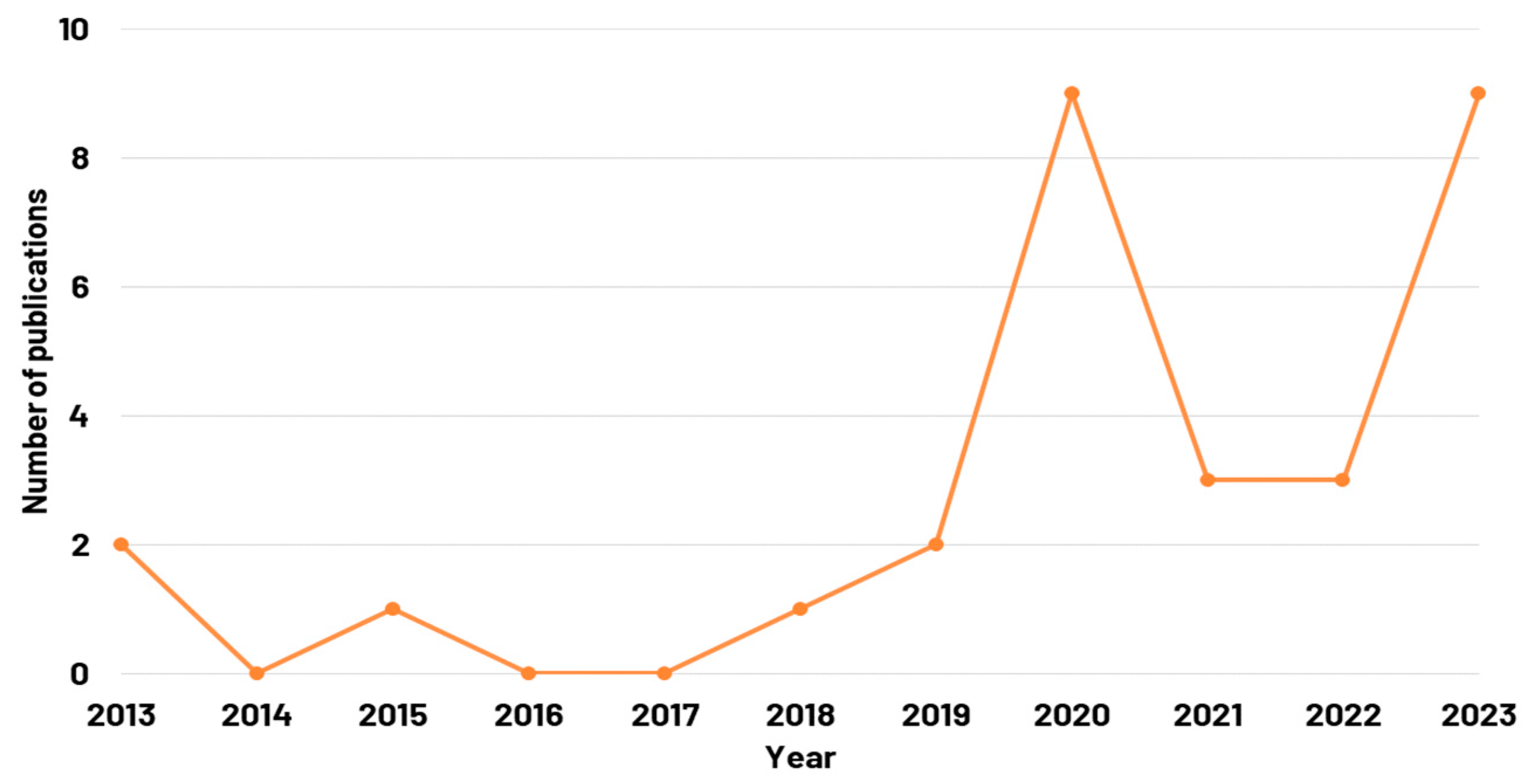
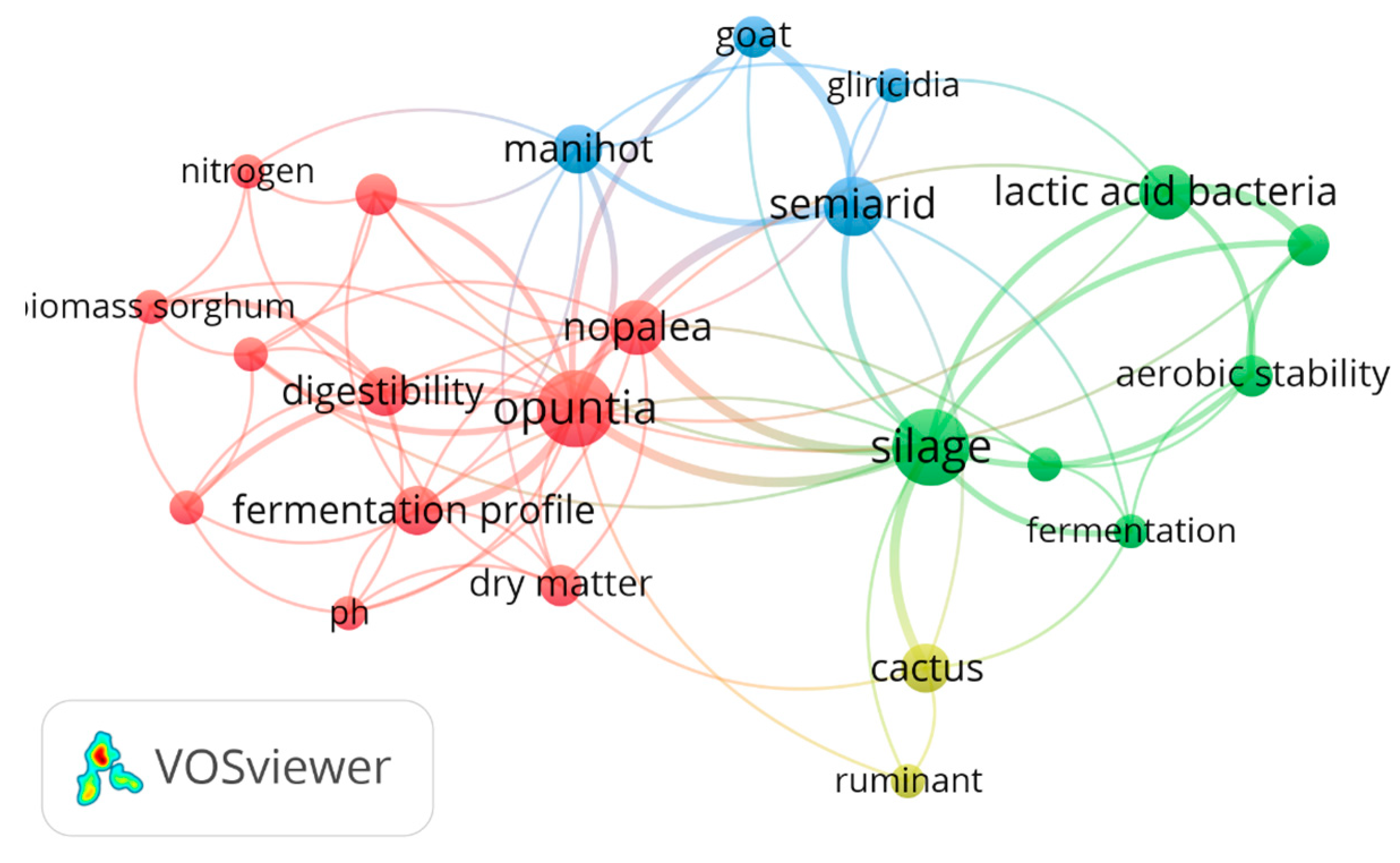
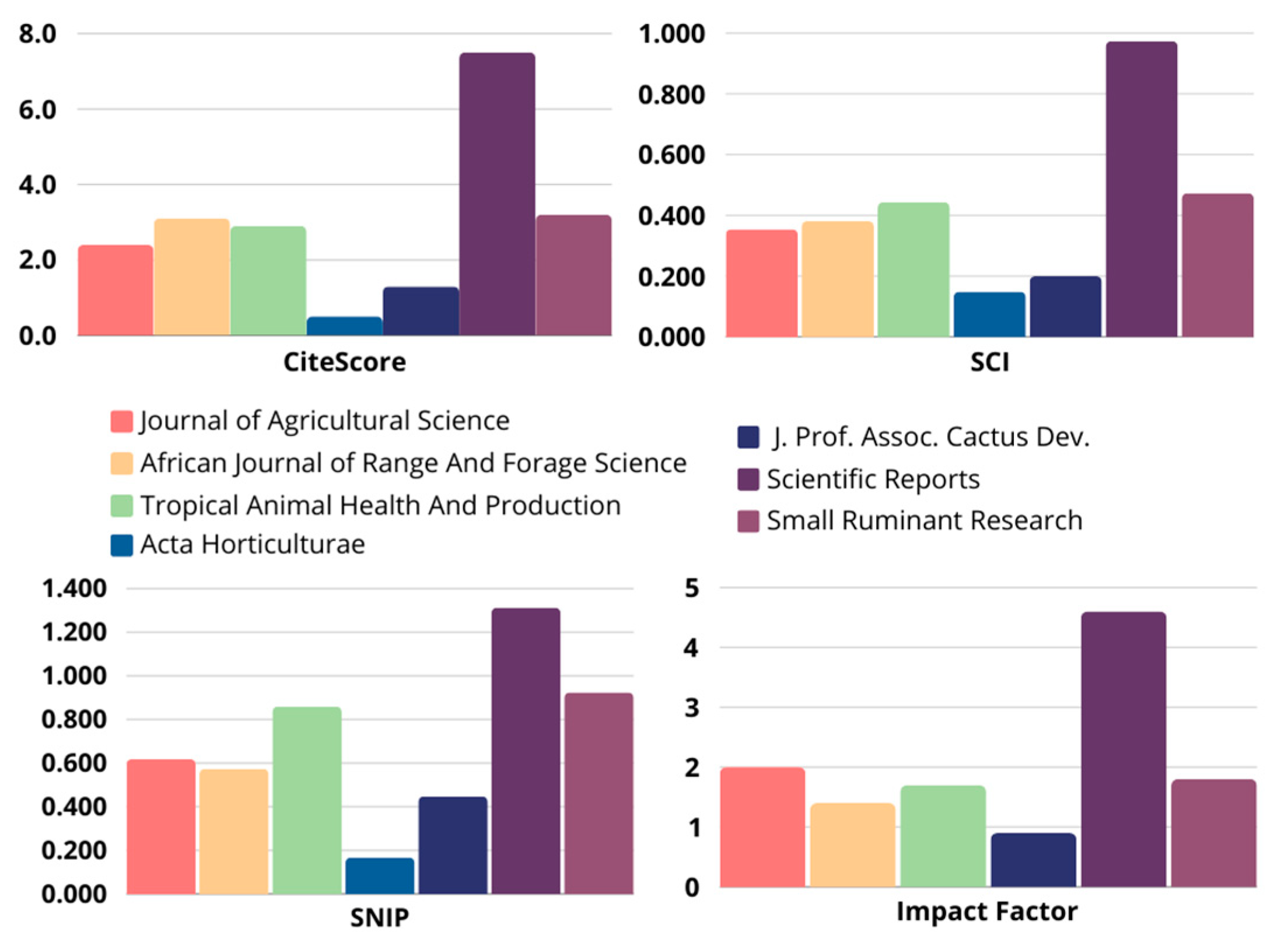
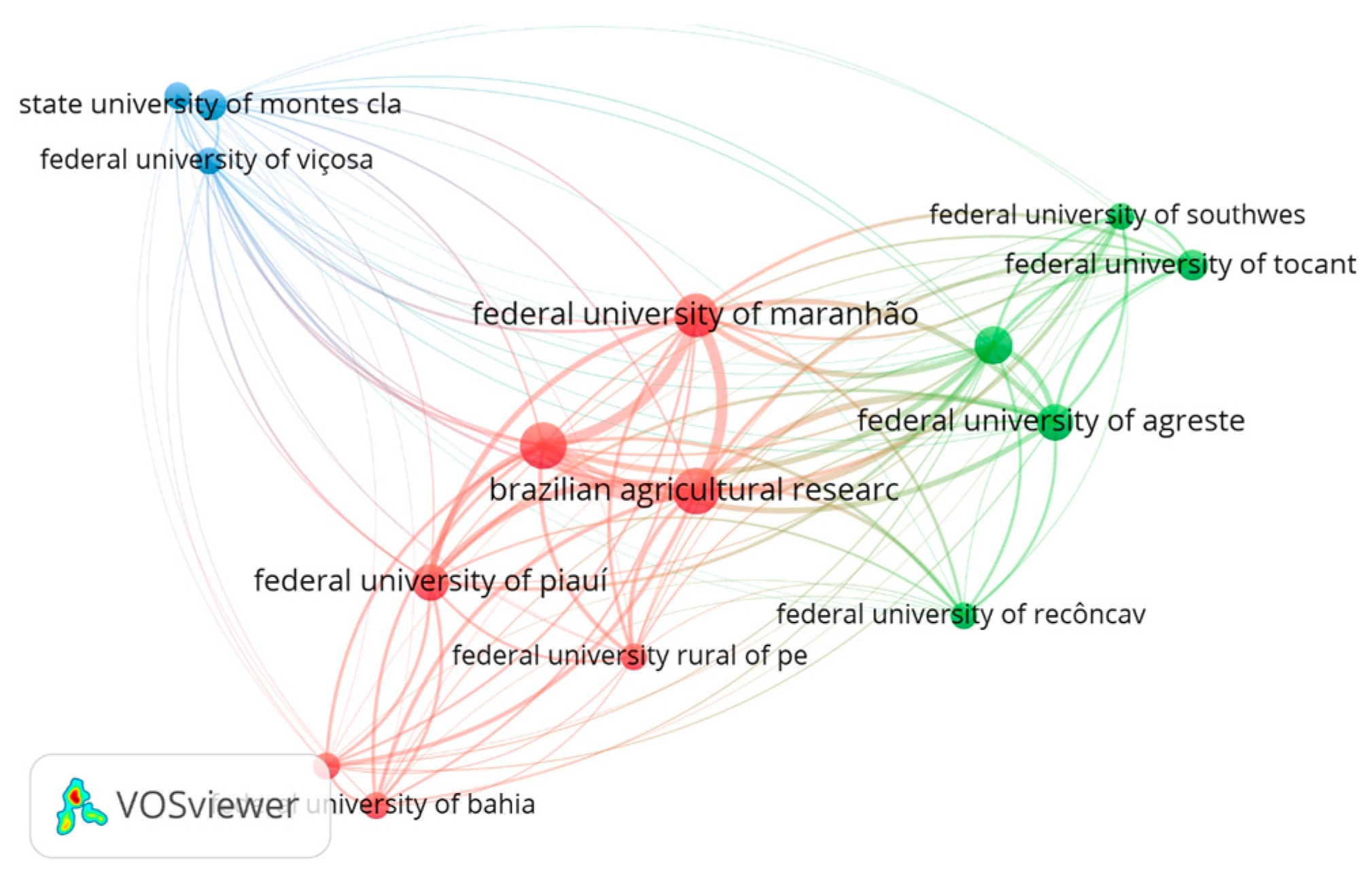
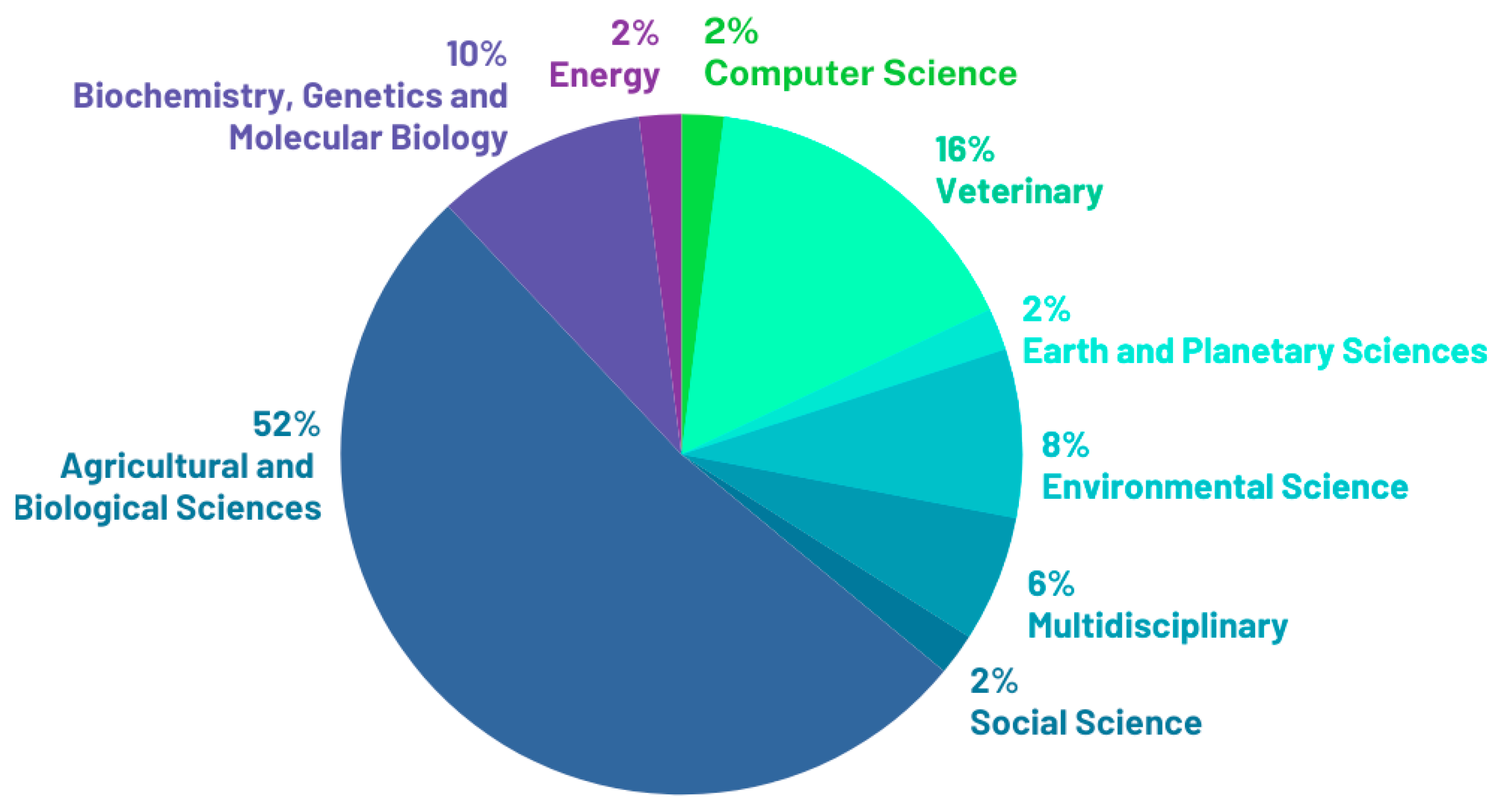
| Keyword | Occurrences |
|---|---|
| Opuntia | 10 |
| silage | 10 |
| semi-arid | 6 |
| lactic acid bacteria | 5 |
| Nopalea | 5 |
| Manihot | 4 |
| cactus | 4 |
| digestibility | 4 |
| fermentation profile | 4 |
| Journal | Number of Documents |
|---|---|
| Journal of Agricultural Science | 4 |
| African Journal of Range and Forage Science | 3 |
| Tropical Animal Health and Production | 3 |
| Acta Horticulturae | 2 |
| J. Prof. Assoc. Cactus Dev. | 2 |
| Scientific Reports | 2 |
| Small Ruminant Research | 2 |
| Country | Number of Documents | Percentage (%) |
|---|---|---|
| Brazil | 25 | 83.3% |
| Chile | 1 | 3.3% |
| Iran | 1 | 3.3% |
| Italy | 1 | 3.3% |
| Mexico | 1 | 3.3% |
| South Africa | 1 | 3.3% |
| Tunisia | 1 | 3.3% |
| Zimbabwe | 1 | 3.3% |
| Affiliation | Country | Documents |
|---|---|---|
| EMPRAPA Semiárido | Brazil | 16 |
| Federal University of Paraíba | Brazil | 15 |
| Federal University of Maranhão | Brazil | 13 |
| Federal University of the São Francisco Valley | Brazil | 7 |
| Federal University of Piauí | Brazil | 6 |
| Federal University of Agreste of Pernambuco | Brazil | 6 |
| Federal University of Tocantins | Brazil | 3 |
| State University of Montes Claros | Brazil | 3 |
| Subject Area | Documents |
|---|---|
| Agricultural and Biological Sciences | 25 |
| Veterinary | 8 |
| Biochemistry, Genetics, and Molecular Biology | 5 |
| Environmental Science | 4 |
| Multidisciplinary | 3 |
| Computer Science | 1 |
| Earth and Planetary Sciences | 1 |
| Energy | 1 |
| Social Sciences | 1 |
| Document Title | Category | Reference |
|---|---|---|
| Carcass traits and meat quality of goats fed with cactus pear (Opuntia ficus-indica Mill) silage subjected to an intermittent water supply | i, v | Cruz et al. [38] |
| Total Mixed Ration Silages Based on Forage Cactus and Xerophile Legumes as Alternatives for Ruminants | ii | Rodrigues et al. [39] |
| Tropical grass silages with spineless cactus in diets of Holstein × Zebu heifers in the semi-arid region of Brazil | vi | Cordeiro et al. [9] |
| Mixed sorghum and forage cactus silage: composition, digestibility, fermentation, and losses | ii | Oliveira et al. [22] |
| Intake, digestibility, nitrogen balance and performance in lamb fed spineless cactus silage associated with forages adapted to the semi-arid environment Spineless cactus silages in diets for lambs | i, ii, iv | Silva et al. [40] |
| Fermentation profile, chemical composition, and aerobic stability of cassava shoots silages with cactus pear | ii | Araújo et al. [41] |
| Quality of mixed silages of sorghum, BRS Capiaçu grass, and cactus pear in a semi-arid region of Brazil | ii | Alencar et al. [23] |
| Qualitative evaluation of total mixed ration silage containing forage cactus and guinea grass as a nutritional alternative for feedlot-finished sheep | i, ii, iv | Sá et al. [42] |
| Nutritional properties and in vitro gas production in cactus pear (Opuntia stricta) and cassava (Manihot esculenta) shoot silages | ii | Araújo et al. [43] |
| Cactus-alfalfa blend silage as an alternative feedstuff for Saanen dairy goats: Effect on feed intake, milk yield and components, blood and rumen parameters | ii, v | Ravari et al. [44] |
| The inclusion of cactus pear changes the fermentation process, chemical composition and aerobic stability of arboreal cotton silages | ii | Melo et al. [45] |
| Effects of browse legume species addition on nutritional composition, fermentation characteristics and aerobic stability of Opuntia cladodes silage | ii | Matlabe et al. [46] |
| Spineless cactus use management on microbiological quality, performance, and nutritional disorders in sheep | i, iv | Paulino et al. [47] |
| Water intake and ingestive behavior of sheep fed diets based on silages of cactus pear and tropical forages | ii, iv | Silva et al. [30] |
| Intake, nutrient digestibility, nitrogen balance, and microbial protein synthesis in sheep fed spineless-cactus silage and fresh spineless cactus | i, iv | Pereira et al. [29] |
| Mixed silages of cactus pear and gliricidia: chemical composition, fermentation characteristics, microbial population and aerobic stability | i, ii | Brito et al. [31] |
| Fermentative characteristics and chemical composition of cochineal nopal cactus silage containing chemical and microbial additives | i | Sá et al. [48] |
| Fermentation profile, microbial populations, taxonomic diversity and aerobic stability of total mixed ration silages based on Cactus and Gliricidia | ii | D. Santos et al. [49] |
| Methods of storing cactus pear genotypes for animal feeding | i | Carvalho et al. [50] |
| Fermentation profile and nutritional quality of silages composed of cactus pear and maniçoba for goat feeding | i, ii, v | Matias et al. [35] |
| Performance, body water balance, ingestive behavior and blood metabolites in goats fed with cactus pear (Opuntia ficus-indica L. Miller) silage subjected to an intermittent water supply | i, v | Albuquerque et al. [34] |
| Nutritional value of BRS capiacu grass (Pennisetum purpureum) silage associated with cactus pear | ii | Monção et al. [51] |
| Fermentation losses of cactus silages with elephant grass | ii | R. S. Santos et al. [52] |
| Carcass traits and meat quality of lambs fed with cactus (Opuntia fíćus-indica Mill) silage and subjected to an intermittent water supply | i, iv | Souza et al. [2] |
| Isolation and identification of lactic acid bacteria in fresh plants and in silage from Opuntia and their effects on the fermentation and aerobic stability of silage | i | Pereira et al. [33] |
| Feed Alternatives with Cactus Forage Silage for Animal Nutrition | i | Nogueira et al. [53] |
| Silages in the form of diet based on spineless cactus and buffelgrass | ii | Macêdo et al. [32] |
| Effect of feeding cactus-legume silages on nitrogen retention, digestibility and microbial protein synthesis in goats | ii, v | Gusha et al. [28] |
| In vitro digestibility of prickly pear cactus (Opuntia spp.) additioned with brewery by-products | i, iii | Fuentes-Rodriguez et al. [54] |
| Silage composed of Opuntia ficus-indica f. inermis cladodes, olive cake and wheat bran as alternative feed for barbarine lamb | iii, iv | Abidi et al. [36] |
Disclaimer/Publisher’s Note: The statements, opinions and data contained in all publications are solely those of the individual author(s) and contributor(s) and not of MDPI and/or the editor(s). MDPI and/or the editor(s) disclaim responsibility for any injury to people or property resulting from any ideas, methods, instructions or products referred to in the content. |
© 2024 by the authors. Licensee MDPI, Basel, Switzerland. This article is an open access article distributed under the terms and conditions of the Creative Commons Attribution (CC BY) license (https://creativecommons.org/licenses/by/4.0/).
Share and Cite
Santos, S.A.; Santana, H.E.P.; Jesus, M.S.; Torquato, I.A.; Santos, J.; Pires, P.; Ruzene, D.S.; Silva, D.P. Progress and Trends in Forage Cactus Silage Research: A Bibliometric Perspective. Fermentation 2024, 10, 531. https://doi.org/10.3390/fermentation10100531
Santos SA, Santana HEP, Jesus MS, Torquato IA, Santos J, Pires P, Ruzene DS, Silva DP. Progress and Trends in Forage Cactus Silage Research: A Bibliometric Perspective. Fermentation. 2024; 10(10):531. https://doi.org/10.3390/fermentation10100531
Chicago/Turabian StyleSantos, Stéfani A., Hortência E. P. Santana, Meirielly S. Jesus, Iran Alves Torquato, Joana Santos, Preciosa Pires, Denise Santos Ruzene, and Daniel Pereira Silva. 2024. "Progress and Trends in Forage Cactus Silage Research: A Bibliometric Perspective" Fermentation 10, no. 10: 531. https://doi.org/10.3390/fermentation10100531
APA StyleSantos, S. A., Santana, H. E. P., Jesus, M. S., Torquato, I. A., Santos, J., Pires, P., Ruzene, D. S., & Silva, D. P. (2024). Progress and Trends in Forage Cactus Silage Research: A Bibliometric Perspective. Fermentation, 10(10), 531. https://doi.org/10.3390/fermentation10100531








